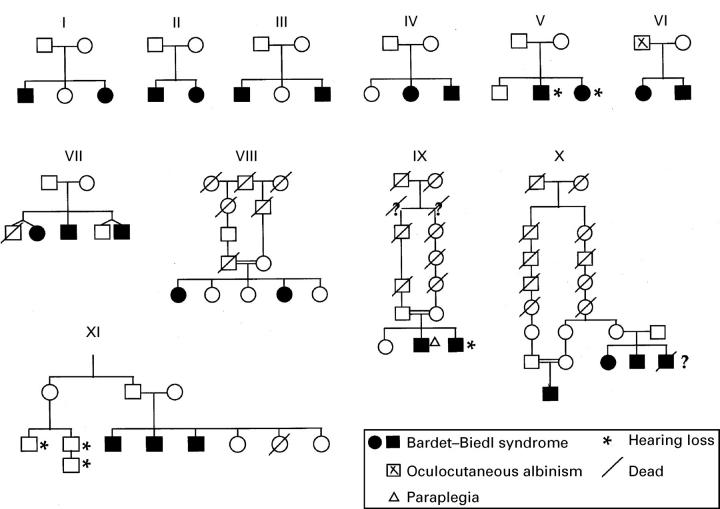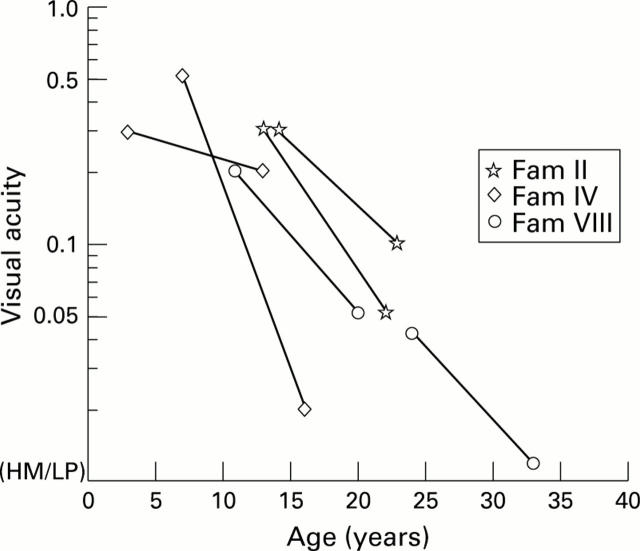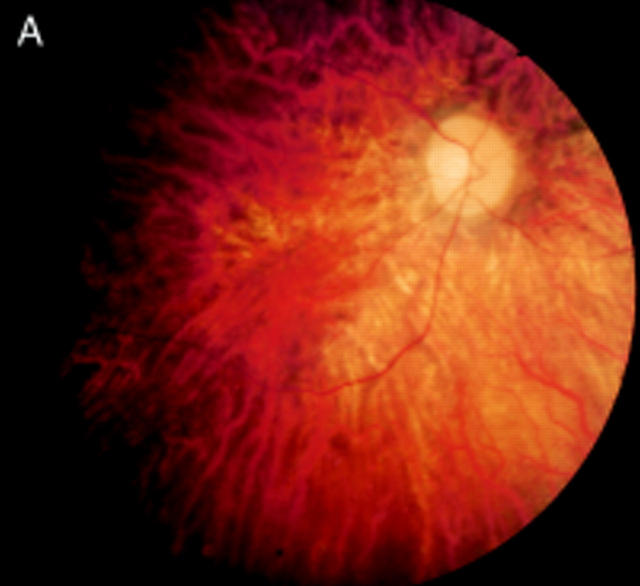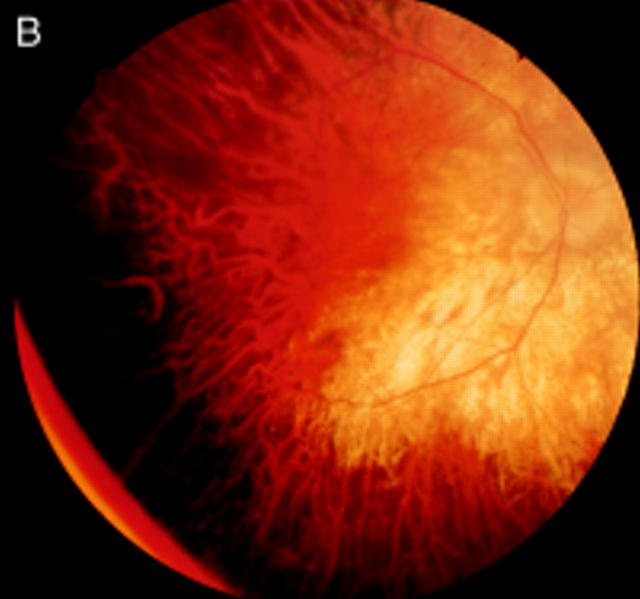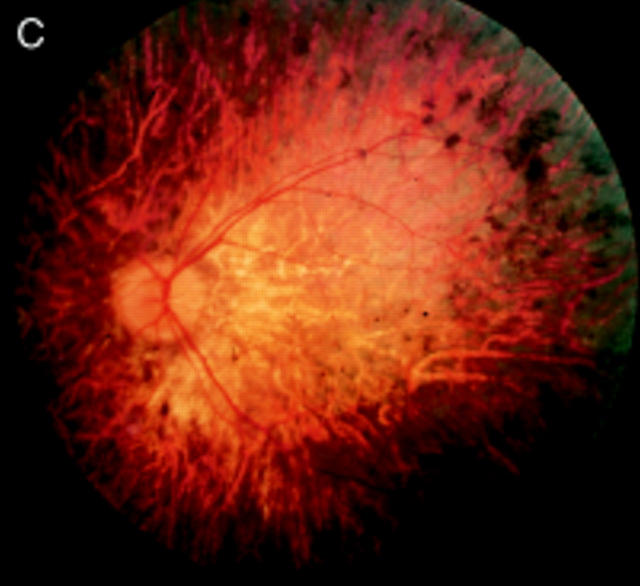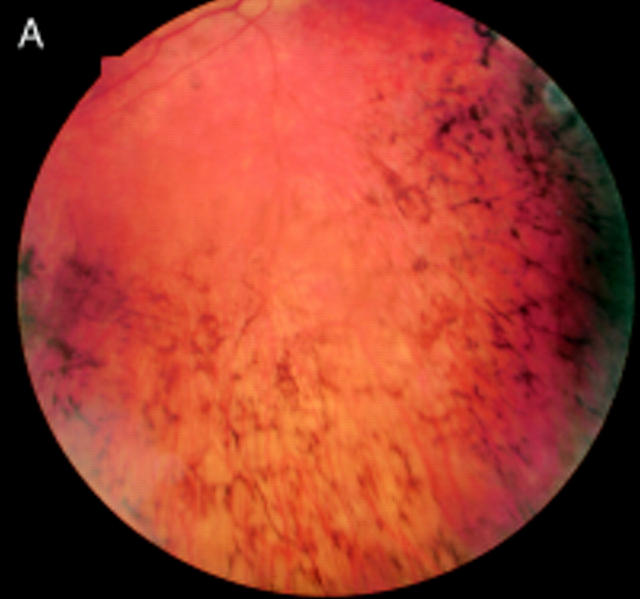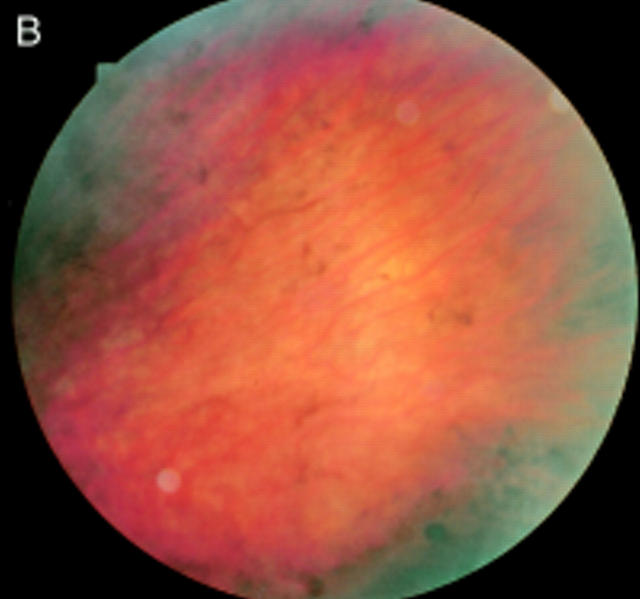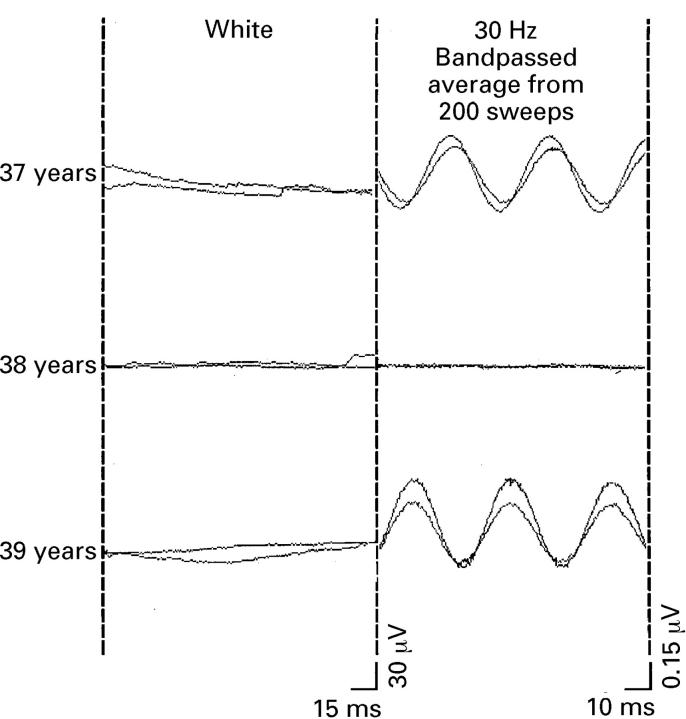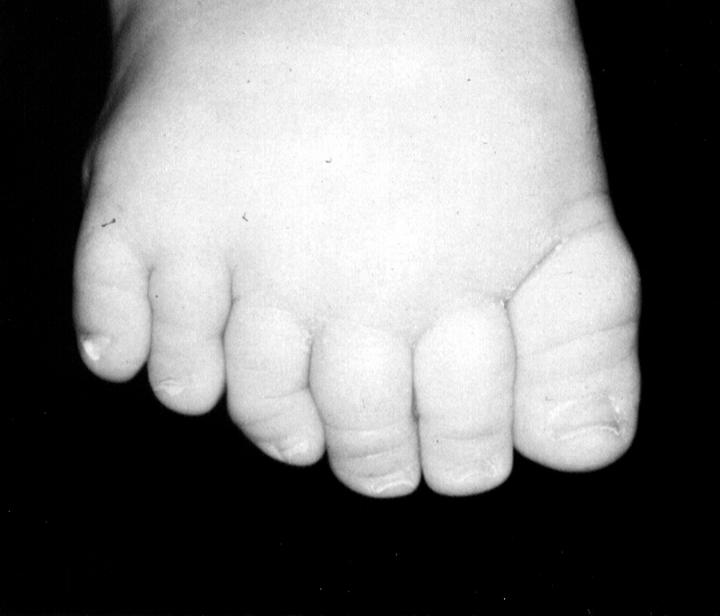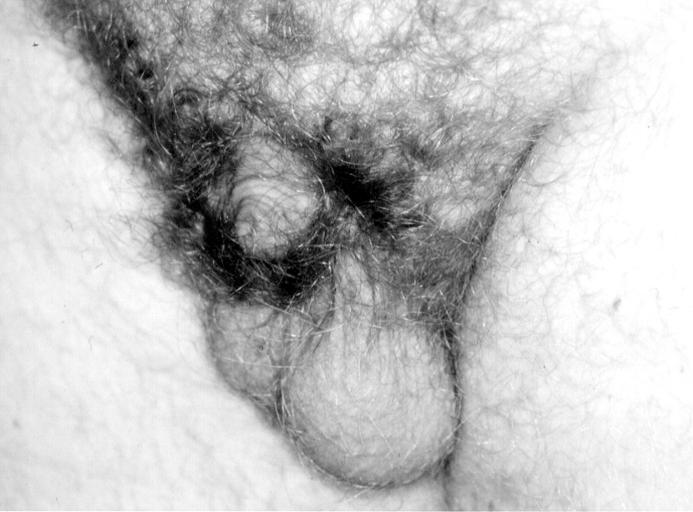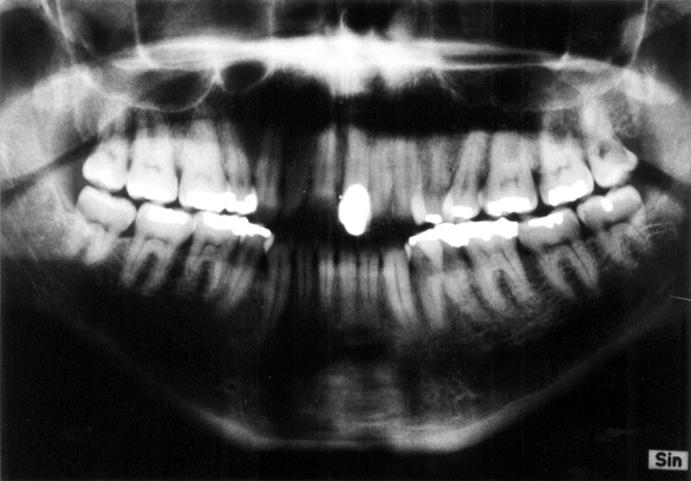Abstract
AIMS—To describe the variation of the phenotype within families with several individuals with Bardet-Biedl syndrome. METHODS—The phenotypes of affected siblings in 11 Scandinavian families were compared with two or more members who had at least three of the features: retinal dystrophy, polydactyly, obesity, hypogenitalism, and mental retardation. Individuals without retinal dystrophy were excluded. RESULTS—Intrafamilial variation of expressivity of the features obesity, polydactyly, abnormal radiograms of the extremities, hypogenitalism, short stature, paraplegia, and dental abnormalities was found. The retinal dystrophy varied with respect to both the onset of symptoms and the course of the disease. The morphology of the fundus, however, was consistent within the families. The disorder showed statistically significant genetic linkage to the BBS4 locus on chromosome 15 in the affected siblings in two of the families, but the clinical features in these patients did not differ from the other cases of Bardet-Biedl syndrome. CONCLUSION—Comparison of siblings with the Bardet-Biedl syndrome showed variation of the typical features. In addition, the course of retinal dystrophy varied. No distinctive clinical features were found to separate the BBS4 phenotype from the remaining patients.
Full Text
The Full Text of this article is available as a PDF (194.6 KB).
Figure 1 .
Pedigrees of 11 Scandinavian families with 25 cases with the Bardet-Biedl syndrome.
Figure 2 .
Visual acuity related to age measured with 9 year interval in three families with two affected siblings. The course of the disease varies in family IV.
Figure 3 .
Ocular fundus of three siblings with BBS (family VII) with a waxy pale optic disc, atrophy of the choroid, narrow or obliterated vessels, and atypical pigmentation in the periphery.
Figure 4 .
Ocular fundus of two siblings with BBS (family I) with typical bone spicules (blurred because of cataract).
Figure 5 .
Full field electroretinograms from three affected siblings (family XI).21 No rod responses to dim blue light could be obtained. The cone flicker amplitude was less than 0.8 µV, which is a severely reduced or non-detectable response even with a bandpass filter. The small differences in the amplitudes are not significant.
Figure 6 .
Polydactyly in the youngest patient in family III. His affected brother had no polydactyly.
Figure 7 .
Micropenis in the male in family I. No hypogenitalism had been noted in his affected sister.
Figure 8 .
Hypodontia (congenitally missing teeth) in one of the affected males in family VII. The affected sister had no dental anomalies.
Selected References
These references are in PubMed. This may not be the complete list of references from this article.
- ALSTROM C. H., HALLGREN B., NILSSON L. B., ASANDER H. Retinal degeneration combined with obesity, diabetes mellitus and neurogenous deafness: a specific syndrome (not hitherto described) distinct from the Laurence-Moon-Bardet-Biedl syndrome: a clinical, endocrinological and genetic examination based on a large pedigree. Acta Psychiatr Neurol Scand Suppl. 1959;129:1–35. [PubMed] [Google Scholar]
- Borgström M. K., Riise R., Tornqvist K., Granath L. Anomalies in the permanent dentition and other oral findings in 29 individuals with Laurence-Moon-Bardet-Biedl syndrome. J Oral Pathol Med. 1996 Feb;25(2):86–89. doi: 10.1111/j.1600-0714.1996.tb00198.x. [DOI] [PubMed] [Google Scholar]
- Carmi R., Elbedour K., Stone E. M., Sheffield V. C. Phenotypic differences among patients with Bardet-Biedl syndrome linked to three different chromosome loci. Am J Med Genet. 1995 Nov 6;59(2):199–203. doi: 10.1002/ajmg.1320590216. [DOI] [PubMed] [Google Scholar]
- Carmi R., Rokhlina T., Kwitek-Black A. E., Elbedour K., Nishimura D., Stone E. M., Sheffield V. C. Use of a DNA pooling strategy to identify a human obesity syndrome locus on chromosome 15. Hum Mol Genet. 1995 Jan;4(1):9–13. doi: 10.1093/hmg/4.1.9. [DOI] [PubMed] [Google Scholar]
- Edwards J. A., Sethi P. K., Scoma A. J., Bannerman R. M., Frohman L. A. A new familial syndrome characterized by pigmentary retinopathy, hypogonadism, mental retardation, nerve deafness and glucose intolerance. Am J Med. 1976 Jan;60(1):23–32. doi: 10.1016/0002-9343(76)90529-5. [DOI] [PubMed] [Google Scholar]
- Escallon F., Traboulsi E. I., Infante R. A family with the Bardet-Biedl syndrome and diabetes mellitus. Arch Ophthalmol. 1989 Jun;107(6):855–857. doi: 10.1001/archopht.1989.01070010877034. [DOI] [PubMed] [Google Scholar]
- Green J. S., Parfrey P. S., Harnett J. D., Farid N. R., Cramer B. C., Johnson G., Heath O., McManamon P. J., O'Leary E., Pryse-Phillips W. The cardinal manifestations of Bardet-Biedl syndrome, a form of Laurence-Moon-Biedl syndrome. N Engl J Med. 1989 Oct 12;321(15):1002–1009. doi: 10.1056/NEJM198910123211503. [DOI] [PubMed] [Google Scholar]
- Hauser C., Rojas C., Roth A., Schmied E., Saurat J. H. A patient with features of both Bardet-Biedl and Alström syndromes. Eur J Pediatr. 1990 Aug;149(11):783–785. doi: 10.1007/BF01957281. [DOI] [PubMed] [Google Scholar]
- Kwitek-Black A. E., Carmi R., Duyk G. M., Buetow K. H., Elbedour K., Parvari R., Yandava C. N., Stone E. M., Sheffield V. C. Linkage of Bardet-Biedl syndrome to chromosome 16q and evidence for non-allelic genetic heterogeneity. Nat Genet. 1993 Dec;5(4):392–396. doi: 10.1038/ng1293-392. [DOI] [PubMed] [Google Scholar]
- Lavy T., Harris C. M., Shawkat F., Thompson D., Taylor D., Kriss A. Electrophysiological and eye-movement abnormalities in children with the Bardet-Biedl syndrome. J Pediatr Ophthalmol Strabismus. 1995 Nov-Dec;32(6):364–367. doi: 10.3928/0191-3913-19951101-08. [DOI] [PubMed] [Google Scholar]
- Lee P. A., Mazur T., Danish R., Amrhein J., Blizzard R. M., Money J., Migeon C. J. Micropenis. I. Criteria, etiologies and classification. Johns Hopkins Med J. 1980 Apr;146(4):156–163. [PubMed] [Google Scholar]
- Leppert M., Baird L., Anderson K. L., Otterud B., Lupski J. R., Lewis R. A. Bardet-Biedl syndrome is linked to DNA markers on chromosome 11q and is genetically heterogeneous. Nat Genet. 1994 May;7(1):108–112. doi: 10.1038/ng0594-108. [DOI] [PubMed] [Google Scholar]
- Nyska M., Mozes G., Howard C., Bar-Ziv J., Dekel S. Quadriparesis in the Laurence-Moon-Biedl-Bardet syndrome: case report. Paraplegia. 1991 Jun;29(5):350–354. doi: 10.1038/sc.1991.50. [DOI] [PubMed] [Google Scholar]
- Riise R., Andréasson S., Tornqvist K. Full-field electroretinograms in individuals with the Laurence-Mood-Bardet-Biedl syndrome. Acta Ophthalmol Scand. 1996 Dec;74(6):618–620. doi: 10.1111/j.1600-0420.1996.tb00747.x. [DOI] [PubMed] [Google Scholar]
- Rizzo J. F., 3rd, Berson E. L., Lessell S. Retinal and neurologic findings in the Laurence-Moon-Bardet-Biedl phenotype. Ophthalmology. 1986 Nov;93(11):1452–1456. doi: 10.1016/s0161-6420(86)33546-2. [DOI] [PubMed] [Google Scholar]
- Rudling O., Riise R., Tornqvist K., Jonsson K. Skeletal abnormalities of hands and feet in Laurence-Moon-Bardet-Biedl (LMBB) syndrome: a radiographic study. Skeletal Radiol. 1996 Oct;25(7):655–660. doi: 10.1007/s002560050153. [DOI] [PubMed] [Google Scholar]
- Schachat A. P., Maumenee I. H. Bardet-Biedl syndrome and related disorders. Arch Ophthalmol. 1982 Feb;100(2):285–288. doi: 10.1001/archopht.1982.01030030287011. [DOI] [PubMed] [Google Scholar]
- Sheffield V. C., Carmi R., Kwitek-Black A., Rokhlina T., Nishimura D., Duyk G. M., Elbedour K., Sunden S. L., Stone E. M. Identification of a Bardet-Biedl syndrome locus on chromosome 3 and evaluation of an efficient approach to homozygosity mapping. Hum Mol Genet. 1994 Aug;3(8):1331–1335. doi: 10.1093/hmg/3.8.1331. [DOI] [PubMed] [Google Scholar]
- Weleber R. G., Carr R. E., Murphey W. H., Sheffield V. C., Stone E. M. Phenotypic variation including retinitis pigmentosa, pattern dystrophy, and fundus flavimaculatus in a single family with a deletion of codon 153 or 154 of the peripherin/RDS gene. Arch Ophthalmol. 1993 Nov;111(11):1531–1542. doi: 10.1001/archopht.1993.01090110097033. [DOI] [PubMed] [Google Scholar]
- Young I. D., Moore J. R. Intrafamilial variation in Cohen syndrome. J Med Genet. 1987 Aug;24(8):488–492. doi: 10.1136/jmg.24.8.488. [DOI] [PMC free article] [PubMed] [Google Scholar]



